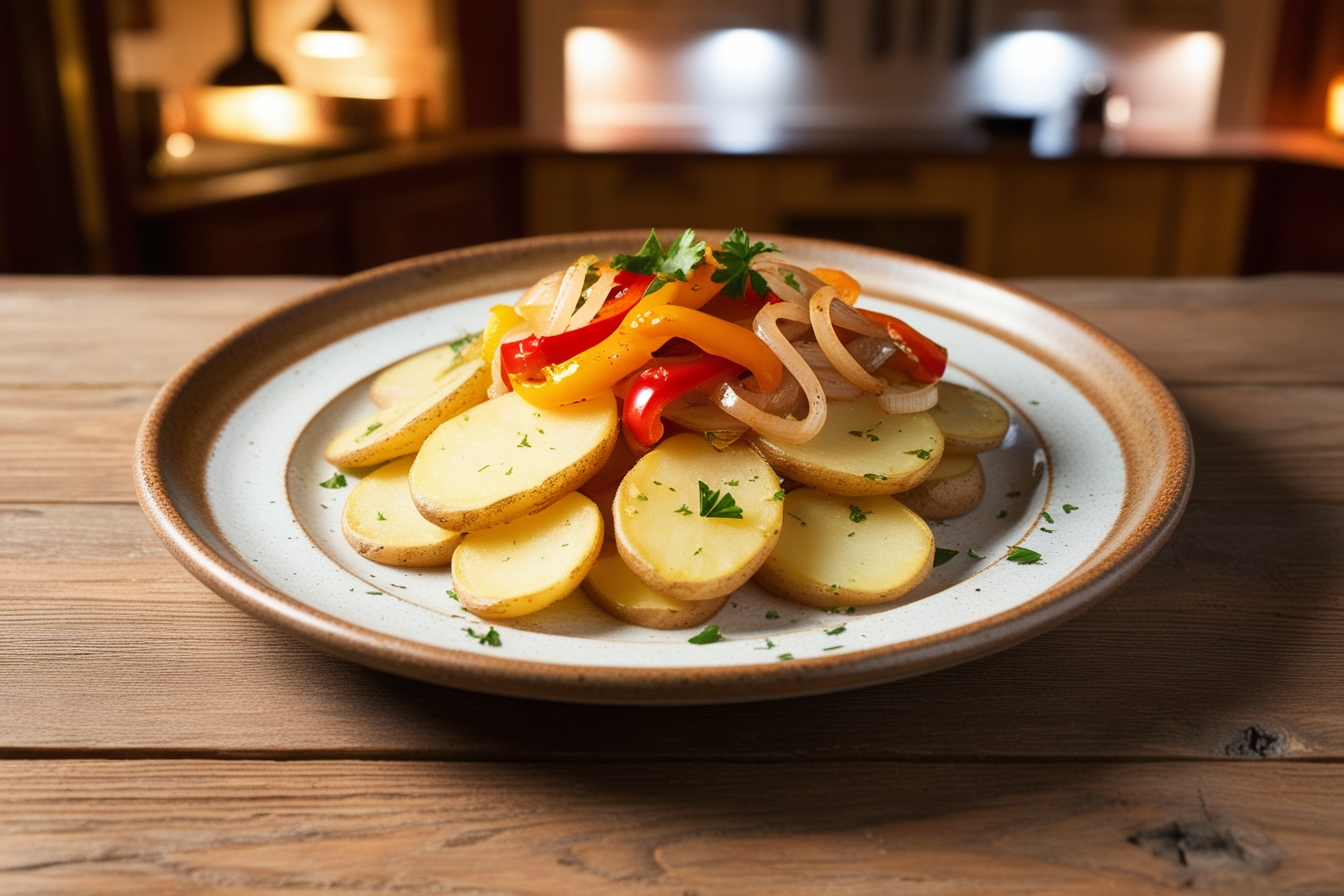Introduction to smothered potatoes
Smothered potatoes, a dish rooted deeply in Southern tradition, combine hearty ingredients with rich flavors to create a satisfying meal. This beloved comfort food showcases tender potatoes cooked to perfection in a savory medley of onions, peppers, and seasonings. Whether served as a side dish or the main star of a meal, smothered potatoes deliver a soul-warming experience. In this article, we’ll explore the origins of this dish, delve into preparation techniques, highlight variations, and answer common questions to ensure your smothered potatoes turn out perfectly every time.
Understanding Smothered Potatoes
Definition and Origins
Smothered potatoes, as the name suggests, involve slow-cooking thinly sliced or diced potatoes in a flavorful base until they are soft and infused with seasonings. Often prepared in a cast iron skillet, this dish has deep roots in Southern and soul food traditions, where resourcefulness and flavor come together in every bite.
What Are Smothered Potatoes?
At their core, smothered potatoes are a method of cooking rather than a specific recipe. The “smothering” technique involves trapping steam by covering the potatoes as they cook, ensuring even cooking and an infusion of rich, savory flavors. This method transforms simple ingredients into a truly mouthwatering dish.
Historical Background
The history of smothered potatoes can be traced back to humble beginnings in the Southern United States, where home cooks embraced simple, affordable ingredients to feed their families. Today, it’s cherished not just for its heritage but for its versatility and unmatched taste.
Cultural Significance in Southern Cuisine
Smothered potatoes are more than just a dish—they’re a symbol of togetherness and ingenuity. Found on dinner tables across the South, these potatoes are often paired with a variety of dishes, showcasing their adaptability.
Regional Variations
Although the foundational concept of smothered potatoes remains the same, regional tweaks give this dish its charm. Some areas emphasize spicy seasonings, while others add different vegetables to reflect local tastes.
Role in Traditional Meals
This dish often stars in comfort food classics, serving as a side to fried chicken, greens, or other Southern staples. Its versatility allows it to fit into a hearty breakfast, a fulfilling lunch, or a cozy dinner.
Essential Ingredients for Smothered Potatoes
Selecting the Right Potatoes
Best Potato Varieties
When it comes to making smothered potatoes, not all spuds are created equal! Russet potatoes are often the go-to choice, thanks to their fluffy interior and ability to absorb flavors. Yukon Golds, on the other hand, offer a creamier texture, while red potatoes maintain their shape well, making them ideal for chunkier dishes.
Importance of Potato Texture
Texture is critical in ensuring the perfect bite. Potatoes with a higher starch content, like Russets, create a soft and cohesive dish, while waxier potatoes bring firmness, ensuring they don’t turn mushy. Choosing the right potato can elevate your dish from ordinary to extraordinary.
Supporting Ingredients
Onions and Peppers
The heart of smothered potatoes lies in the aromatic base. Onions and bell peppers add sweetness and depth to the dish. Yellow onions are ideal for their balance of pungency and sweetness, while colorful bell peppers introduce both vibrancy and flavor.
Fats and Oils
For that rich, savory flavor, you’ll need fats like butter, olive oil, or vegetable oil. Each option contributes a unique taste: butter offers creaminess, while oils like olive oil lend a slightly fruity note.
Seasonings and Herbs
Seasoning is where the magic happens. A sprinkle of garlic powder, paprika, and black pepper brings warmth and complexity. Fresh herbs like parsley or thyme enhance the dish’s aroma, creating a balance between earthy and savory.
Step-by-Step Preparation Guide
Prepping the Vegetables
Peeling and Slicing Techniques
Peeling is optional for some potatoes, but if you prefer a smoother texture, ensure your potatoes are peeled thoroughly. Slice them uniformly to achieve even cooking; aim for slices around ¼-inch thick. Thinner slices cook faster but may break apart, so balance is key.
Uniformity for Even Cooking
For consistent results, use a mandoline slicer or a sharp knife. Uneven slices can lead to some pieces being overcooked while others remain underdone, so precision is crucial.
Cooking Process
Sautéing Onions and Peppers
Begin by heating your skillet on medium heat and adding your fat of choice. Toss in the onions and peppers, stirring occasionally, until they soften and their natural sweetness comes through. The caramelization adds depth that’s hard to beat.
Adding and Browning Potatoes
Once your aromatics are ready, layer the potatoes into the skillet. Season them generously as they cook, allowing the potatoes to brown slightly. This step enhances their flavor and prevents them from becoming bland.
Simmering to Perfection
Finally, reduce the heat and cover the skillet to trap steam, “smothering” the potatoes. Cook them slowly, stirring occasionally to prevent sticking. When the potatoes are tender and infused with the seasoning, they’re ready to serve.
Common Mistakes to Avoid
Overcrowding the Pan
When you overcrowd the skillet, potatoes steam instead of browning, leading to a soggy texture. Use a wide pan to ensure each slice has room to cook evenly.
Incorrect Heat Levels
Too high of heat can scorch the potatoes before they’re cooked through, while too low may leave them underdone. Maintain a steady medium heat and adjust as needed for the perfect finish.
Popular Variations of Smothered Potatoes
Adding Proteins
Smothered Potatoes with Sausage
For a hearty twist, add slices of smoked or spicy sausage to your smothered potatoes. Saute the sausage alongside the onions and peppers, letting the flavors meld together as the potatoes cook. The savory depth sausage brings pairs perfectly with the creamy texture of the potatoes, making it a meal on its own.
Incorporating Ham
If you’re looking to repurpose leftover ham, dice it into small chunks and toss it in during the simmering stage. The ham’s salty and smoky notes enhance the dish’s overall taste. Alternatively, cubed ham steak works wonderfully to provide protein and elevate the flavors.
Vegetarian and Vegan Options
Using Plant-Based Fats
Vegan smothered potatoes can be just as delicious with a few simple swaps. Replace butter with margarine or coconut oil for a creamy texture. Olive oil also works well, giving a subtle fruitiness to the dish.
Enhancing with Additional Vegetables
Vegetarian options shine with added vegetables like mushrooms, zucchini, or spinach. Mushrooms provide an earthy flavor, while zucchini adds a tender bite, and spinach contributes vibrant color and nutrients. These additions not only enhance the flavor but also make the dish more filling.
Serving Smothered Potatoes
Ideal Pairings
Breakfast Combinations
Smothered potatoes are a breakfast staple in many households. Pair them with scrambled eggs, grits, or a stack of fluffy pancakes for a Southern-inspired breakfast. Add a side of turkey sausage or plant-based patties for an extra layer of flavor.
Dinner Entrees
For dinner, smothered potatoes complement roasted chicken, grilled fish, or vegetable stir-fry beautifully. They also shine as a side for classic Southern favorites like fried catfish or slow-cooked greens.
Presentation Tips
Garnishing Ideas
A sprinkle of fresh parsley or chives can add a pop of color and a hint of freshness. For a slight kick, try a dusting of paprika or red pepper flakes.
Serving Styles
Serve your smothered potatoes directly from a cast iron skillet for a rustic, homey feel. Alternatively, use a decorative serving bowl and layer the dish with garnishes to impress your guests at family gatherings or potlucks.
Nutritional Profile of Smothered Potatoes
Caloric Content and Macronutrients
Smothered potatoes strike a balance between comfort food and nutrition. A serving typically contains around 200–300 calories, depending on the preparation and added ingredients. Potatoes are naturally rich in carbohydrates, providing energy, while the addition of fats and proteins from oils, butter, or sausage enhances the macronutrient profile.
Impact of Different Ingredients
The nutritional value can vary greatly based on your choices. Using olive oil adds healthy monounsaturated fats, while butter increases saturated fat content. Adding vegetables like spinach or bell peppers boosts fiber and vitamins, making the dish both filling and nutrient-dense.
Health Considerations
Reducing Fat and Sodium
To make smothered potatoes healthier, use a non-stick skillet with minimal oil or opt for plant-based fats. Reducing the amount of salt and choosing low-sodium broth can significantly lower the sodium content without sacrificing flavor.
Enhancing Nutritional Value
You can increase the nutritional value by adding nutrient-dense ingredients. Try tossing in spinach, kale, or even sweet potatoes for added vitamins and minerals. Using a blend of herbs and spices instead of heavy sauces also ensures a flavorful yet healthier dish.
Storage and Reheating Guidelines
Proper Storage Techniques
Refrigeration and Freezing
Store leftover smothered potatoes in an airtight container in the refrigerator for up to 3–4 days. For longer storage, freeze them in a freezer-safe container or bag, ensuring all air is removed to prevent freezer burn. They can stay fresh for up to three months when properly frozen.
Reheating Methods
Maintaining Texture and Flavor
Reheat your potatoes on the stovetop for the best results, adding a splash of water or broth to restore moisture. Alternatively, use the microwave for convenience, but keep the heat low to avoid drying out the dish. For a crispier texture, consider reheating them in the oven at 350°F for 10–15 minutes.
FAQs about Smothered Potatoes
Can I use different types of potatoes?
Absolutely! While Russet potatoes are a classic choice due to their fluffiness and ability to soak up flavors, you can experiment with Yukon Golds for a creamier texture or red potatoes for firmer slices. Sweet potatoes can even be used for a unique twist, providing natural sweetness and added nutrition. Regardless of the variety, the key is to select potatoes that complement the dish’s overall flavor and texture.
How do I prevent the potatoes from becoming mushy?
To keep your potatoes from turning mushy, ensure they are cut into uniform slices or cubes to cook evenly. Avoid overcooking them by maintaining medium heat and stirring occasionally during the simmering stage. Using waxy potatoes like red or yellow varieties can also help, as they tend to hold their shape better than starchy ones like Russets.
Can smothered potatoes be made ahead of time?
Yes, smothered potatoes can be prepared in advance. Cook them as directed, then allow them to cool completely before storing in an airtight container in the refrigerator. When reheating, add a bit of water or broth to restore their creamy consistency and heat gently on the stovetop to preserve their flavor and texture.
What are some common mistakes to avoid when making smothered potatoes?
One common mistake is overcrowding the pan, which prevents even cooking and can result in soggy potatoes. Another is using too high of heat, causing the outer layer to burn while the inside remains undercooked. Lastly, neglecting to season during each stage of cooking can lead to bland potatoes, so be sure to layer your flavors as you go.
Are there vegan versions of smothered potatoes?
Certainly! To make vegan smothered potatoes, replace butter with plant-based alternatives like margarine or coconut oil. Use vegetable broth instead of chicken broth for simmering. Adding extra vegetables like zucchini, spinach, or mushrooms not only enhances flavor but also adds a nutritional boost, making it a wholesome vegan-friendly dish.
How can I add more flavor to my smothered potatoes?
For an extra flavor kick, experiment with spices like smoked paprika, cayenne pepper, or garlic powder. Adding fresh herbs like thyme, rosemary, or parsley toward the end of cooking can elevate the dish. Including sautéed garlic or a splash of lemon juice can also bring brightness and depth to the overall flavor profile.
Looking for a tasty side dish to pair with your Smothered Potatoes? Check out this recipe for Rotel Cream Cheese Sausage Balls

